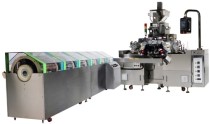
Nelson has a long history of performing research projects for customers and performing custom encapsulation of your paint, liquid, paste, or gel product.
One of the most popular uses of our custom encapsulation abilities is producing custom paintballs with special fills and single-use packaging and product sample packaging. A few examples of the products we have engineered include:
- A single-use gun oil capsule utilizing the #6 twist off capsule from chart. Large firearms manufacturers use it in their packaging.
- A single-use quicklock adhesive capsule using the #8 snip tube, from chart, for medium-sized adhesives companies product samples.
- A Specialty chemical in a .68 caliber round capsule with an after-process heat-resistant coating applied for use in furnaces and boilers.
- An herbicide in a .68 caliber projectile for use in eradication of invasive species plants.
Nelson's encapsulation provides a much-less-expensive container for product samples compared to comparable-volume plastic tubes or envelopes, and allow for easier use and more precise application. Since the capsule is biodegradable, there are no disposal concerns-the capsule can be left where used and within weeks it has gone back into the environment in a natural state.
Some of the products we have encapsulated include:
- Adhesives
- Oils
- Greases
- Dye concentrates for dispersion in aqueous (water), glycol, and solvent bases.
- Lubricants
- Penetrants
- Scents
- Solvents
- Herbicides
- Herbicide custom blends
- Pesticides
- Pesticide custom blends
- Specialty Chemicals
- Custom Designed Paints
Nelson is an EPA-registered Pesticide Producing Establishment, #86199-MI-001
In addition to EPA registration, our company also manufactures paints, coatings, and solvents in full compliance with all occupational safety and environmental laws. We have the chemical knowledge and expertise, formulating expertise, Softgel manufacturing knowledge and expertise, general manufacturing experience and marketing talent to help you bring your product from concept to the marketplace.
The Nelson staff is dedicated to providing a creative, cooperative approach to finding solutions that meet our clients' needs, and we offer a very fast turnaround of your project.
At Nelson, our teams of highly qualified individuals generate an open communication channel to produce a flexible, multi-faceted problem solving process. From the beginning stages of researching the viability of a new encapsulation idea, to implementing improvements on your already existing products, Nelson Paint Company will work with you to bring your ideas to the market.
We are willing and able to provide innovative thinking and additional processing of your product to meet your unique requirements.
The general steps for a custom encapsulation run are as follows:
- An NDA (either the customers or Nelson's) is executed, if desired by the customer.
- The customer discusses the project goal and Nelson determines the feasibility.
- If the project is viable and the customer wishes to continue, a project quote is provided.
- The trial research and Development project is encapsulated.
- Full Scale production can then be pursued.
We communicate clearly with the customers to ensure their satisfaction and understanding at the processes at play with successful encapsulation of unique products into a Softgel product. Some projects are easily accomplished, some are more difficult.

Steps in the Encapsulation Process
Step One - Gelatin Preparation
Powdered gelatin is mixed with water until a liquid gelatin is formed in a reactor. The reactor serves as a gelatin-melting tank. It is important that this process is done quickly and that minimal air is in the gelatin. When color is added to the gelatin - it is done so by a high-speed vacuum mixer - again to decrease the amount of added air to the gelatin. The gelatin is stored in heated tanks until used.
Step Two - Encapsulation
Forming the Gelatin Ribbon The gelatin is supplied to the encapsulation machine through a gravity driven system. The gel is sent to the machine and two ribbons of gelatin are formed. The ribbons of gelatin are cooled and lubricated with non-toxic oil. The gelatin is now ready to be shaped and filled.
Filling the Capsule
The two ribbons of gelatin are run through recessed dies of the desired shape and size. The ribbon of gelatin is forced into the recessed areas of the die by the chosen fill material. At the same time the capsule is filled within the die it is sealed and cut from the ribbon of gel.
Step Three - Drying of Capsules
Stage One - Capsules that have just been filled are very soft due to the amount of moisture they contain. Therefore they are sent immediately through a tumble dryer via a conveyor. The main purpose of the tumble dryer is to remove the thin layer of oil on the outside of the capsule as well as some of the moisture in the gelatin.
Stage Two - After being tumble dried, the capsules are placed on trays and moved into rooms that are climate controlled to continue drying. Air is circulated around the trays of capsules for up to 48 hours.
Step Four - Inspection
Before any capsules are packaged they are inspected for uniformity, proper filling and to make sure there are no air pockets in the gelatin or dimples in the shell.
Step Five - Packaging
Once the capsules are completed they are packaged in bulk packaging and readied for shipment.
